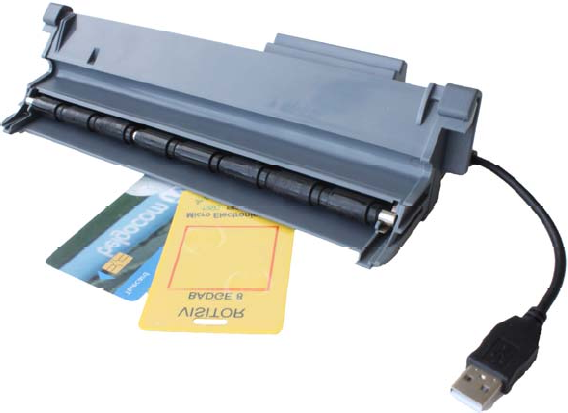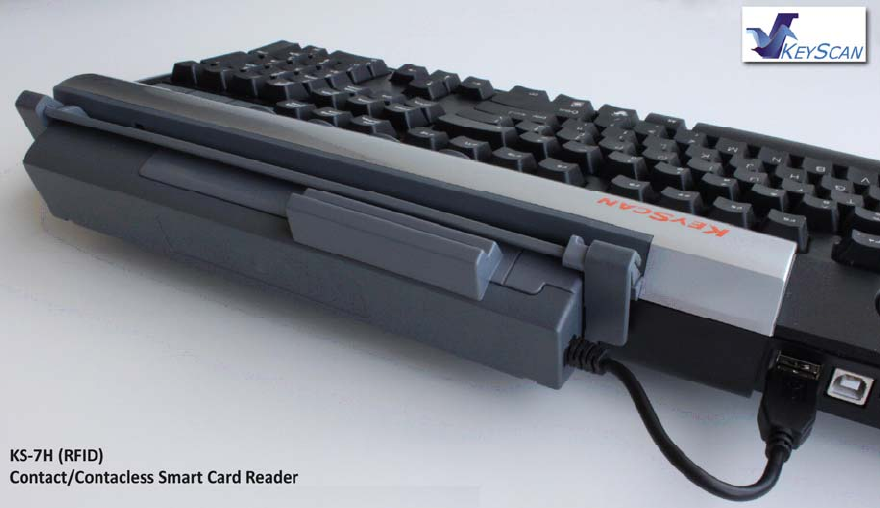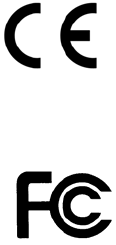KeyScan KSM0007 Contact & Contactless smart card reader User Manual KS 7H English
KeyScan Inc. Contact & Contactless smart card reader KS 7H English
KeyScan >
User manual

KeyScanLtd.Allrightsreservedwww.keyscan.com
KeyScan KS-07H
Contact & Contactless (RFID) Smart Card Reader
Add-on attachment for KS810-P Imaging-Keyboard
User Manual
KeyScan reserves the right to modify the product spec without prior notice
29-Aug-2010
All Trademarks are the property of their respective owners
Spec data is subject to change without notice

KeyScanLtd.Allrightsreservedwww.keyscan.com
Introduction
KeyScan KS-7H is a combined contact and contactless (RFID) smart card reader.
It is specially designed as an add-on attachment to the back of the KeyScan KS810-P Imaging-
Keyboard. This unique configuration produces a powerful all in one input device that include: a
full size keyboard, a full size sheet-feed optical document scanner, a fast USB2.0 hub (with one
free downstream port) and a combined contact and contactless smart card reader.
Overview
The KS-7H is a smart card reader, both contact and contactless connected to the PC.
It is uniquely attached to the KS810-P Imaging-Keyboard in such way that it saves space and
reduces the clutter of wires on the user desk by having it connected to a USB hub which is built
in the KS810-P Imaging-Keyboard, drawing both power and data from the keyboard USB
connection to the computer.
The KS-7H contains inside its housing the HID Global OK5121 contact and contactless smart
card reader module. This implies that any technical and operational data, device drivers and
applications that works with the OK5121 should be able to work without any modifications with
the KS-7H reader.
The KS-7H reads 13.56 MHz (RFID) contactless smart cards. This reader is also equipped with
a contact interface, which reads/writes to virtually any contact smart card.
For contactless operation, hold the card on top or near the back of the reader.
For contact smart cards, insert the card with contacts facing away from the user.
KeyScanLtd.Allrightsreservedwww.keyscan.com
Specifications
Add-on attachment to the back of KS810-P Imaging-Keyboard
Dimensions (Approx. with the KS810-P door): 10.5” x 2.5” x 3”
Weight (Approx.): 0.6 lbr
Operating Temperature: 0°-55°C / 32°-131°F
Operating Humidity: 10-90% rH
Contact Interface Durability: 100,000 Insertions
Meantime between Failure (MTBF): 500,000 Hours
Host Interface: USB 2.0 CCID
Host Data Transmission Speed: 12 Mbps (USB 2.0 Full Speed)
Power Supply: USB Bus powered
Contact smart card interface:
Standards: ISO 7816 & EMV2 2000 Level 1
Protocols: (T=0, T=1; 2-wire: SLE 4432/42 (S=10);
3-wire: SLE 4418/28 (S=9); I2C (S=8) )
Card size: ID-1 (full-size)
Smart Card interface speed: 420 Kbps (when supported by card)
Smart Card clock frequency: Up to 8 MHz
Supported card types: (5V, 3V and 1.8V Smart Cards;
ISO 7816 Class A, AB and C)
Power to Smart Card: 60 mA
Smart Card detection: movement detection with auto power-off;
Automatic detection of: smart card type short circuit and
Thermal protection
Contactless smart card interface:
ISO 14443 A with 424 Kbps transmission rate (depending on card)
ISO 14443 B with 424 Kbps transmission rate (depending on card)
ISO 15693 with 26 Kbps transmission rate (depending on card)
Contactless (RFID)
Smart Card Interface: ISO 14443 A with 424 Kbps transmission rate (depending on card)
ISO 14443 B with 424 Kbps transmission rate (depending on card)
ISO 15693 with 26 Kbps transmission rate (depending on card)
Supported APIs
PC/SC driver (ready for 2.01)
CT-API (on top of PC/SC, for contact interface)
OCF (on top of PC/SC, for contact interface)
Synchronous API (on top of PC/SC)
Minimum system requirements:
Attach to a KeyScan KS810-P Imaging Keyboard
Windows XP, Vista, Windows7 (32/64 bits versions)
KeyScanLtd.Allrightsreservedwww.keyscan.com
Installation:
This device contain 2 smart card reader interfaces
Contact interface & contactless interface
The contact reader may not require any software driver installation.
The contactless interface require the installation of the OK5121 contactless reader device driver
The drivers can be downloaded from KeyScan web site, as drivers for KS-7H or from HID
Global web site as drivers for OK5121 contact and contactless smart card reader
Installation of additional smart-card device driver may be required per specific smart-card type
and its on-card operating system, please consult you smart-card vendor
KeyScan recommend that this device will be installed only by IT professionals with the proper
experience in installation of such data security devices.
Installation steps:
1. Do not connect the KS-7H USB connector to the KS810-P USB hub, you must install the
driver software before such connection
2. Install the KS-7H device drivers, you must install it as administrator.
3. Remove the back scanner door of the KS810-P product
4. Insert the KS-7H instead of the back door of the KS810-P
5. Verify that the device is recognized by the operating system
6. Test the device using contact and contactless cards

KeyScanLtd.Allrightsreservedwww.keyscan.com
KS-7H Conformance Information
CE Marking
This device complies with the requirements of the
directives 89/336/EWG, 73/23/EWG and 1999/5/EG.
Declaration of Conformity (FCC ID: YNO-KSM0007)
This device complies with Part 15 of the FCC rules.
Operation is subject to the following two conditions:
(1) this device may not cause harmful interference, and
(2) this device must accept any interference received, including interference that
may cause undesired operation.
Any changes or modifications not expressly approved by the party responsible for
compliance could void the user's authority to operate the equipment.
NOTE: This equipment has been tested and found to comply with the limits for a Class B
digital device, pursuant to Part 15 of the FCC Rules. These limits are designed to provide
reasonable protection against harmful interference in a residential installation. This
equipment generates, uses and can radiate radio frequency energy and, if not installed
and used in accordance with the instructions, may cause harmful interference to radio
communications. However, there is no guarantee that interference will not occur in a
particular installation. If this equipment does cause harmful interference to radio or
television reception, which can be determined by turning the equipment off and on, the
user is encouraged to try to correct the interference by one or more of the following
measures:
-- Reorient or relocate the receiving antenna.
-- Increase the separation between the equipment and receiver.
-- Connect the equipment into an outlet on a circuit different from that to which the receiver
is connected.
-- Consult the dealer or an experienced radio/TV technician for help.